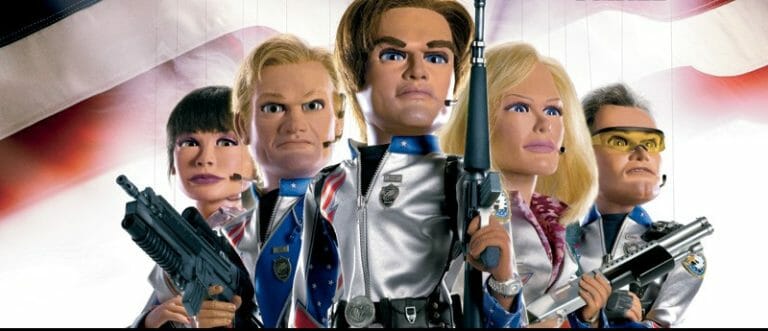Sign up for the
TSL Newsletter
and get $50 off Final Draft 12
By Rebecca Norris · August 30, 2020

Writing a montage scene is a tricky task for most screenwriters. They’re often torn between the need to push the story forward and anxiety about using what some see as a lazy narrative crutch. And while it’s important to be cautious about overusing the technique, there are a hundreds of great examples of great montages that not only progress the story, but also provide satisfying character development in a short amount of screen time. You just have to know how to format your montage scene correctly.
So here’s a quick guide to the pros and cons of writing a montage into your script and three simple ways to format a montage so you can get through the boring parts and get back to the good stuff as quickly as possible.
One of the best (and most obvious) examples of how—and why—you should write a montage is the brilliant “Montage Song” scene from Team America. Yes, that Team America.
When forced to accelerate the character development of the protagonist in a hilariously short amount of time, Team America dives headfirst into a brief 60-second montage that literally spells out why this montage exists. And while it’s incredibly funny, it’s also full of surprisingly good advice for how to use a montage in your script.
Here are a few choice lines of montage writing advice from the song:
“Show us the passage of time, we’re gonna need a montage! (Montage!)
Oh, it takes a montage! (Montage!)
Show a lot of things happening at once,
Remind everyone of what’s going on. (What’s going on!)
And with every shot you show a little improvement,
To show it all would take too long,
That’s called a montage (Montage!)”
This simple, ridiculous montage still works. And that’s because it plays by the rules of good montage writing, namely it:
A good montage can not only save a writer time, but can accelerate character growth in a pinch and trim down a ballooning screenplay. Even better, montages are a visually versatile storytelling technique that works for just about any genre. Some classic montage examples include:
Whether your character is gearing up for war of trying on twenty seven dresses—a good montage will always include the same basic elements. Time passes, we see incremental progress, and a character grows toward their goal. That’s all you have to accomplish.
And the best part about montages is that unlike many other screenplay elements, there isn’t necessarily a right or wrong way to format them. The key is just to make a montage simple and clear so that a reader can easily understand what’s happening on screen. Let’s pull from the above examples and say that you need to show a character going on a series of bad dates. Here are three different ways you can format that in a montage scene:
A simple way to write a montage is to break the scenes of your montage up into a bullet-point style list (with two dashes in front of each scene). The dashes make your montage especially easy to read and understand the passage of time. Make sure to designate MONTAGE and END MONTAGE so the reader knows when it starts and ends.
INT. VARIOUS RESTAURANTS – NIGHT
Kelsey goes on terrible first dates, each one worse than the last.
MONTAGE
–Kelsey yawns and signals to the waiter for another glass of wine while a guy drones on about himself.
–To Kelsey’s shock, a guy polishes off his meal and then reaches over and helps himself to half the food on her plate.
–A handsy guy repeatedly puts his hand on Kelsey’s leg, and she slaps it away.
–A guy guzzles down a beer and then slams the glass down next to five other beers he just polished off. Burps and blows it in Kelsey’s face.
END MONTAGE
This style of montage formatting is simple, visually clear, and easy to read, and should work for most montage scenes.
If lists aren’t your thing, don’t worry. You can keep your montage in line with the rest of the narration in your script by using paragraph-style formatting. Just make sure that you’re clear about what’s happening from scene to scene. And again, include MONTAGE tags at the beginning and end of the montage scenes.
INT. VARIOUS RESTAURANTS – NIGHT
MONTAGE as Kelsey goes on terrible first dates, each one worse than the last. On one date, we see Kelsey yawn and signal to the waiter for another glass of wine while a guy drones on about himself. The next date, to Kelsey’s shock, another guy polishes off his meal and then reaches over and helps himself to half the food on her plate.
On yet another date, a handsy guy repeatedly puts his hand on Kelsey’s leg, and she slaps it away. Finally, a guy guzzles down a beer and then slams the glass down next to five other beers he just polished off. Burps and blows it in Kelsey’s face.
END MONTAGE
This style of formatting blends the montage seamlessly into the existing script. Just make sure it doesn’t blend in too much.
The third and final way to format a montage in a screenplay is to break it up into a series of short scenes. The reader will pick up on the fact that it’s supposed to be a montage onscreen.
INT. ITALIAN RESTAURANT – NIGHT
Kelsey yawns and signals to the waiter for another glass of wine while a guy drones on about himself.
INT. MEXICAN RESTAURANT – NIGHT
To Kelsey’s shock, a guy polishes off his meal and then reaches over and helps himself to half the food on her plate.
INT. SWANKY BAR – NIGHT
A handsy guy repeatedly puts his hand on Kelsey’s leg, and she slaps it away.
INT. GASTROPUB – NIGHT
A guy guzzles down a beer and then slams the glass down next to five other beers he just polished off. Burps and blows it in Kelsey’s face.
If you feel the need for more clarity, use the MONTAGE tags at the beginning and end of your montage scenes.
Again, there’s no right or wrong to format a montage. Just choose the style that works best for you and communicates your vision the most clearly. As long as your reader understands that they’re seeing a montage, you’re going to be fine. You may find that you use different montage formats for different scripts, and even different formats in the same script!
And if you need a little help remembering why you’re writing a montage, just hum the “Montage Song.” It’s surprisingly effective.
 Rebecca Norris is a producer, writer, and filmmaker with her production company, Freebird Entertainment. Her recent award-winning feature film, Cloudy With a Chance of Sunshine, has been distributed on Amazon Streaming and DVD. Rebecca is also a script analyst and consultant who has read for many companies, including Sundance, ScreenCraft, Bluecat, and the International Emmys, as well as her own script consultancy, Script Authority. Rebecca blogs for Screencraft, The Script Lab, WeScreenplay and Script Magazine, exploring the film writing and production process and encouraging writers to produce their own work. Follow Rebecca’s posts on Twitter at @beckaroohoo!
Rebecca Norris is a producer, writer, and filmmaker with her production company, Freebird Entertainment. Her recent award-winning feature film, Cloudy With a Chance of Sunshine, has been distributed on Amazon Streaming and DVD. Rebecca is also a script analyst and consultant who has read for many companies, including Sundance, ScreenCraft, Bluecat, and the International Emmys, as well as her own script consultancy, Script Authority. Rebecca blogs for Screencraft, The Script Lab, WeScreenplay and Script Magazine, exploring the film writing and production process and encouraging writers to produce their own work. Follow Rebecca’s posts on Twitter at @beckaroohoo!
For all the latest from The Script Lab, be sure to follow us on Twitter, Facebook, and Instagram.